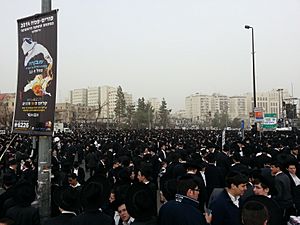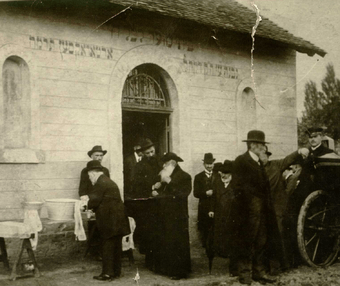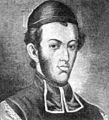Orthodox Judaism facts for kids
| Part of a series on | |||
|---|---|---|---|
|
|||
| Judaism | |||
| Category | |||
| Jewish religious movements | |||
| Orthodox (Haredi • Hasidic • Modern) | |||
| Conservative • Reform | |||
| Reconstructionist • Renewal • Humanistic | |||
| Jewish philosophy | |||
| Principles of faith • Kabbalah • Messiah • Ethics | |||
| Chosenness • Names of God • Musar | |||
| Religious texts | |||
| Tanakh (Torah • Nevi'im • Ketuvim) | |||
| Ḥumash • Siddur • Piyutim • Zohar | |||
| Rabbinic literature (Talmud • Midrash • Tosefta) | |||
| Religious Law | |||
| Mishneh Torah • Tur | |||
| Shulchan Aruch • Mishnah Berurah | |||
| Kashrut • Tzniut • Tzedakah • Niddah • Noahide laws | |||
| Holy cities | |||
| Jerusalem • Safed • Hebron • Tiberias | |||
| Important figures | |||
| Abraham • Isaac • Jacob | |||
| Moses • Aaron • David • Solomon | |||
| Sarah • Rebecca • Rachel • Leah | |||
| Rabbinic sages | |||
| Jewish life cycle | |||
| Brit • Pidyon haben • Bar/Bat Mitzvah | |||
| Marriage • Bereavement | |||
| Religious roles | |||
| Rabbi • Rebbe • Posek • Hazzan/Cantor | |||
| Dayan • Rosh yeshiva • Mohel • Kohen/Priest | |||
| Religious buildings & institutions | |||
| Synagogue • Beth midrash • Mikveh | |||
| Sukkah • Chevra kadisha | |||
| Holy Temple / Tabernacle | |||
| Jewish education | |||
| Yeshiva • Kollel • Cheder | |||
| Religious articles | |||
| Sefer Torah • Tallit • Tefillin • Tzitzit • Kippah | |||
| Mezuzah • Hanukiah/Menorah • Shofar | |||
| 4 Species • Kittel • Gartel | |||
| Jewish prayers and services | |||
| Shema • Amidah • Aleinu • Kaddish • Minyan | |||
| Birkat Hamazon • Shehecheyanu • Hallel | |||
| Havdalah • Tachanun • Kol Nidre • Selichot | |||
| Judaism & other religions | |||
| Christianity • Islam • Judeo-Christian | |||
| Abrahamic faiths | |||
| Related topics | |||
| Antisemitism • The Holocaust • Israel • Zionism | |||
Orthodox Judaism is the term for the traditionalist and theologically conservative branches of contemporary Judaism. It regards the Torah, both Written and Oral, as revealed by God to Moses on Mount Sinai and faithfully transmitted ever since.
Orthodox Judaism advocates a strict observance of traditional Jewish law, or halakha. Key practices are:
Orthodox Jews believe in a future Messiah who will restore Jewish practice by building the temple in Jerusalem and gathering all the Jews to Israel, belief in a future bodily resurrection of the dead, divine reward for the righteous and punishment for the sinners.
Orthodox Jews may be divided between Haredi Judaism, which is more conservative and reclusive, and Modern Orthodox Judaism, which is relatively open to outer society. Each of those groups regards Orthodoxy not as a variety of Judaism, but as Judaism itself.
Daily life
Orthodox Judaism emphasizes practicing rules of kashrut, Shabbat, family purity, and tefilah (daily prayer).
Many Orthodox Jews can be identified by their manner of dress and family lifestyle. Orthodox men and women dress modestly by keeping most of their skin covered. Married women cover their hair, with scarves (tichel), snoods, turbans, hats, berets, or wigs.
Orthodox men are expected to wear a ritual fringe called Tzitzit, and the donning of a head-covering for males at all times is a well-known attribute distinguishing Orthodox Jews. Many men grow beards, and Haredi men wear black hats with a skullcap underneath and suits. Modern Orthodox Jews are sometimes indistinguishable in their dress from general society, although they, too, wear kippahs and tzitzit; additionally, on Shabbat, Modern Orthodox men wear suits (or at least a dress shirt) and dress pants, while women wear fancier dresses or blouses.
Orthodox Jews also follow the laws of negiah, which means "touch". Orthodox men and women do not engage in physical contact with those of the opposite sex outside of their spouse, or immediate family members (such as parents, grandparents, siblings, children, and grandchildren). Kol Isha is the prohibition of a woman's (singing) voice to a man.
Doorposts have a mezuzah; separate sinks for meat and dairy have become increasingly common.
Groups
Haredim

The most recognizable sub-group is the Haredim (literally, "trembling" or "fervent"), also known as "strictly Orthodox", and the like. Haredim are characterized by a minimal engagement with modern society and culture. Some Haredim also hold a lukewarm or negative assessment of the more modernist Orthodox. They are easily discerned by their mode of dress, often all black for men and very modest, by religious standards, for women (including hair covering, long skirts, etc.).
Apart from that, the ultra-Orthodox consists of a large spectrum of communities. They may be roughly classified into three different sub-groups.
Hasidic Jews
The first of the three Haredi sub-groups are the Hasidic Jews. The Hasidim originated in 18th-century Eastern Europe. Each Hasidic community has a hereditary leader known as rebbe (who is almost always, though not necessarily, an ordained rabbi). Rebbes exercise tight control over the lives of their followers. Every single one of the several hundreds of independent Hasidic groups/sects (also called "courts" or "dynasties"), from large ones with thousands of member households to very small, has its own line of rebbes. "Courts" often possess unique customs, religious emphases, philosophies, and styles of dress. Hasidic men, especially on the Sabbath, don long garments and fur hats, which were once the staple of all Eastern European Jews, but are now associated almost exclusively with them. As of 2016, there were 130,000 Hasidic households worldwide.
Litvaks
The second Haredi group are the "Litvaks", or "Yeshivish". They became defined by affiliation with their yeshivas. The "Litvak" sector is led mainly by heads of yeshivas.
Sephardic Haredim
The third ultra-Orthodox movement is the Sephardic Haredim. While living in strictly observant circles (there are several hundreds of Sephardic-Haredi communal rabbis), they, unlike the insular Hasidim or Litvaks, maintain a strong bond with the non-Haredi masses of Israeli Mizrahi society.
Images for kids
-
Moses Sofer of Pressburg, considered the father of Orthodoxy in general and ultra-Orthodoxy in particular.
-
Young Samson Raphael Hirsch, the ideologue of Orthodox secession in Germany.
-
Beth Medrash Govoha (Hebrew:בית מדרש גבוה), in Lakewood, New Jersey, U.S., the world's largest yeshiva outside Israel
-
Haredi schoolgirls at the Western Wall.
See also
 In Spanish: Judaísmo ortodoxo para niños
In Spanish: Judaísmo ortodoxo para niños












